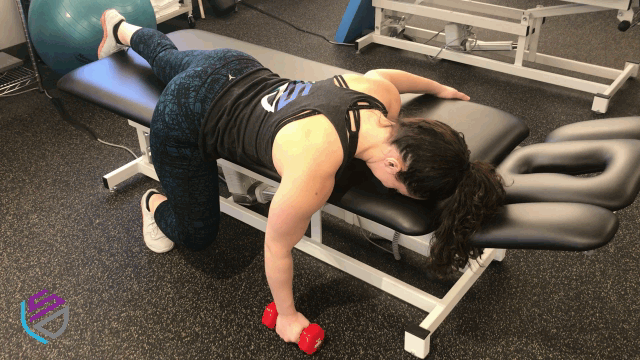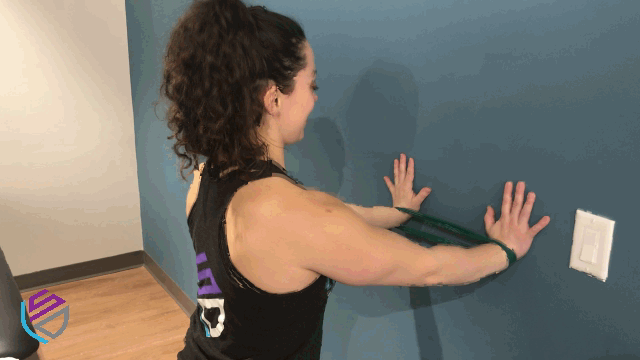Complex movements are hard to perform well. They require activation of both major movers and accessory muscles in precise sequences when performed correctly. But our bodies are lazy. They love to take shortcuts and easily fall into bad movement patterns. And our bodies have natural differences between antagonistic sets of muscles. That leads to imbalances in strength around our joints and the potential for injury and instability. But we can solve that with a proper shoulder warmup.
Our shoulders are one of the least stable joints in the body, requiring a lot of muscle activation to remain centered during heavy lifting. Without this muscle activation, heavy lifting can cause excessive stress on the solid structures of the shoulder leading to labrum tears, rotator cuff tears, and cartilage damage.

Dr. James Larson is an orthopedic surgeon specializing in sports medicine and arthroscopic surgery. He also holds a CF-L1 certificate and is a Certified BFR Specialist. He supports weight training and high-intensity exercise throughout the lifespan. He started LSO to keep more people moving better, longer.
If you read this blog regularly, you’ll know that I say this to encourage safe fitness techniques and habits, not to discourage you from exercise. This is why I recommend specifically targeting shoulder stabilizing muscles before doing exercises like cleans, overhead press, pull-ups, or burpees. This will help improve the strength and endurance of your stabilizing muscles as well as ingrain healthy motor patterning.
If you are serious about fitness, I recommend that you take the time to add full accessory workouts to your training regimen. But if you don’t have the luxury of spending multiple hours in the gym each day, these exercises make a great shoulder warmup before WOD’s (workout of the day) with a lot of upper body work.
If you are a coach, trainer, or gym owner looking for some direction on warm-ups, feel free to use these in your programming!
Shoulder Stabilization Exercises
There are three major components to shoulder stability. And so I’m going to organize these warm-up exercises according to which component of shoulder stability they mostly apply to. Of course, there will be some overlap, but these categorizations are mostly based on electromyography studies that show which muscles are firing the most with different exercises. The three major components of shoulder stability are Scapular Stabilization, Rotator Cuff Strength, and Dynamic Stabilization.
Step 1 – Scapular Stabilization
These exercises target the muscles that hold the shoulder blade to the rib cage. Did you know that there are 17 muscles that attach to the scapula? And its only bony junction with the chest is at the collarbone, which forms a sort of kickstand for the shoulder. So when you move heavy weights with your upper body, you are relying on a complex interplay of all seventeen of these muscles. They must work properly together so that the shoulder blade stays clamped tightly against the ribcage, providing a solid foundation for energy transference and work.
Without a strong base of support, you can’t hope for good stability of the shoulder when exercising. And poor scapular kinematics are a common cause of shoulder injuries. That’s why physical therapists focus on scapular stabilization and control as the first step in rehabbing an injured shoulder. And it’s why you should focus on it during warm-ups to prevent injury.
Which Muscles to Target For Scapular Stability
While there are many muscles attached to the shoulder blade, we are going to focus first on the ones which help keep it anchored to the rib cage during motion. These exercises will target the following muscles, which are instrumental in scapular stability:
- Serratus Anterior
- Lower and Middle Trapezius fibers
- Rhomboid Major
- Rhomboid Minor
Exercises For Scapular Stability

Reverse Flys
These Reverse Flys have been scientifically proven to be one of the best exercises for activation and strengthening of your scapular stabilizers.

Scapular Pull-Ups
Scapular Pull-Ups are a great warmup for any workout where you will be hanging from the bar.

Banded Scap Sets
If you want to work on just one shoulder at a time, you can do banded scap sets instead of the scapular pull-ups.

Banded Scap Retraction
Be sure to pinch the shoulders DOWN and back to get proper activation. Have someone watch to be sure you aren’t shrugging while performing this motion.

Reverse Snow Angels
Keep your hands off the ground for this one. Only the tips of your fingers should brush the surface as you move the arms back and forth.

Blackburns
Also known as “Y,T,I” exercises, these are well-known physical therapy movements for strengthening the muscles around your shoulder blade.

Scapular Press-Ups
Similar to push-ups, but in this case you are only moving the shoulders relative to the torso. Keep the elbows nice and straight and your core tight!
Step 2 – Rotator Cuff Strengthening
The rotator cuff is a set of four muscles that help to keep the ball centered in the socket of the shoulder. They are small muscles but have a major function in shoulder motion and stability. By centering the ball in the socket, they allow all the other muscles to lift and move the arm. But they have to endure a lot of stress and strain. This is why they tear so often and why keeping them strong is so important. This means it’s great to target them during a shoulder warmup.
When trying to target the rotator cuff, it is important to minimize activity in the other muscles of the shoulder, such as the deltoid. In order to do this, use light resistance such as elastic bands or dumbbells of 5 pounds or less. An athlete with a healthy shoulder should be able to do sets of 20-30 before starting to feel the deep burn of the cuff tiring out.
What are the Rotator Cuff Muscles?
- Supraspinatus (the most commonly torn)
- Infraspinatus
- Subscapularis
- Teres Minor
Exercises for Rotator Cuff Strength

Resisted External Rotation
These can be performed with light dumbells laying on your side like this, or with an elastic band between your hands while standing upright.

Resisted Internal Rotation
Using a light resistance band, work the subscapularis by pulling the hand in toward the body.

Saber Pulls
This motion is named because it looks like you are pulling a sword out of its sheath. Pull the weight from the opposite hip and out to the other side at about shoulder height.
Step 3 – Dynamic Shoulder Stability
The last part of our shoulder warmup puts it all together. We want to be sure that our shoulders are not only stable in a single position, but during activity as well. So these exercises will provide variable resistance during motion of the arm. This will help your shoulder stabilizing muscles learn how to work together to provide dynamic stability during exercises. It’s okay to start adding a bit of weight to these as your shoulder learns better how to balance the resistance as it wobbles around.
Which Muscles To Target for Dynamic Shoulder Stability
Rather than focusing on the strength of specific muscles, these exercises focus on the coordination between all the groups of muscles we’ve already worked on. Think of this section as teaching your shoulder how to balance properly.
Exercises for Dynamic Shoulder Stability

Banded Wall Walk
Place a resistance band loop around your wrists, widen your hand position enough to produce tension, and then walk them up and down the wall.

Ball-On-Wall Circles
Use a light slam ball or medicine ball, 5lbs or less is fine. Make sure to rotate both clockwise and counter-clockwise to get full training.

Scapular Punch
Laying on a foam roller will give your shoulder the excursion needed for this movement to work, and also add to the instability and balance needed. For an added degree of difficulty, try holding the kettlebell in the “bottom up” position.

Bottom-Up Overhead Press
Holding a kettlebell in the “bottom-up” position can take a simple shoulder press and turn it into a real balancing act. This will work your wrist strength as well!

Walking Plank
Try to keep a tight core and wobble as little as possible while doing this one.
How To Create A Shoulder Warmup
If you want to put together a quick shoulder warmup before a workout involving a lot of upper body training, just take one exercise from each category above. Do thirty seconds of each of them. Then repeat two or three times. Remember, this is more about activating the muscles and reinforcing proper motor patterning rather than building strength. You are simply trying to use proper form to reinforce the neuromuscular pathways and make shoulder stabilization an unconscious part of your lifts. No need to go heavy, and don’t expect to feel tired.
- Pick one exercise from each of the three sections
- do thirty seconds of each of them
- repeat two or three times until your shoulders are warm and active
If you are looking to add a shoulder accessory routine to your program for high-level function, you can do 3-4 of each of these. Turn them into a dedicated workout of 30-45 minutes in addition to your regular training program twice a week and build yourself some resilient and sturdy shoulders!

